Mushrooms
Media

Species Types
Scientific Name
Exidia alba (Ductifera pululahuana)
Description
Pale jelly roll is a small, white, gelatinous fungus with an irregular shape. It looks like a brain, or like jelly — or both! It grows in clusters on dead wood of deciduous trees.
Media

Species Types
Scientific Name
Ganoderma sessile (formerly G. lucidum)
Description
The ling chih is a hard, usually flat, zoned bracket fungus with a reddish brown, shiny top. It grows at the base of living and dead deciduous trees, and also around stumps.
Media
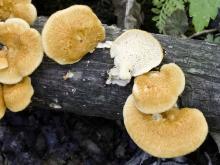
Species Types
Scientific Name
Polyporus alveolaris (formerly Favolus alveolaris)
Description
This polypore is an orange to tan, fan-shaped bracket that is scaly on top; the underside has rows of white, six-sided, radially arranged pores. It grows singly or in groups on dead branches of deciduous trees.
Media
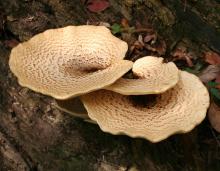
Species Types
Scientific Name
Polyporus squamosus
Description
The dryad's saddle is a large, fleshy, scaly, yellowish tan bracket fungus with large, yellowish white pores and a short stalk; it smells like watermelon rind. It grows singly or in layers, on living or dead deciduous wood.
Media
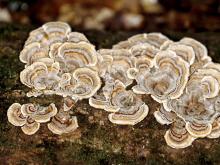
Species Types
Scientific Name
Trametes versicolor
Description
Turkey tail grows in clusters of leathery, thin brackets with multicolored zones above and whitish yellow pores below. Look for it on stumps and logs of deciduous trees.
Media

Species Types
Scientific Name
Amanita spp. (about 600 species, worldwide)
Description
This large group of mushrooms accounts for 90 percent of mushroom-related deaths, so every mushroom hunter should be familiar with amanitas. They contain one of the deadliest poisons found in nature!
Media
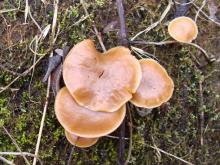
Species Types
Scientific Name
Galerina marginata (G. autumnalis)
Description
The deadly galerina has a brownish, sticky cap, yellowish to rusty gills, and a ring on the stalk. It grows scattered or clustered on deciduous and coniferous logs.
Media
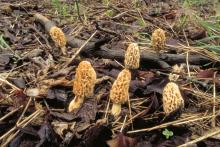
Species Types
Scientific Name
Morchella species
Description
Favorites among Missouri wild edibles, true morels only appear in the spring. They're very hard to see, but that's part of the fun of hunting them. Learn to identify them, and you can enjoy the hunt, too.
Media

Species Types
Scientific Name
Morchella esculentoides (formerly M. esculenta)
Description
The yellow morel is a choice edible mushroom. It has a honeycombed cap with yellow to grayish to tan ridges and pits. It is completely hollow and grows in the spring.
Media

Species Types
Scientific Name
Fuligo septica
Description
In addition to "dog vomit" and "scrambled eggs," this slime mold can also look like the foam at the top of a pint of stout beer, or a yellow or tan sponge. It grows on mulch and other decaying wood.
See Also



Media

Species Types
Scientific Name
Monotropa hypopitys
Description
Pinesap is a plant that puts the "wild" in wildflower! It lacks chlorophyll, so its roots connect to fungi underground and absorb nutrients from the fungi.
Media

Species Types
Scientific Name
Cladophora, Pithophora, and Spirogyra spp., and others
Description
Filamentous green algae forms green, cottony masses that are free-floating or attached to rocks, debris, or other plants.
Media

Species Types
Scientific Name
Monotropa uniflora
Description
Indian pipe lacks chlorophyll, so it is white, not green. Below ground, its roots join with fungi that connect to tree roots. This plant, then, takes nourishment indirectly from the trees.
About Mushrooms in Missouri
Mushrooms are a lot like plants, but they lack chlorophyll and have to take nutrients from other materials. Mushrooms are neither plants nor animals. They are in a different kingdom — the fungi. Fungi include the familiar mushroom-forming species, plus the yeasts, molds, smuts, and rusts.
Always be cautious when eating edible mushrooms. Be absolutely sure of the ID, and only eat a small amount the first time you try it to avoid a reaction..





















